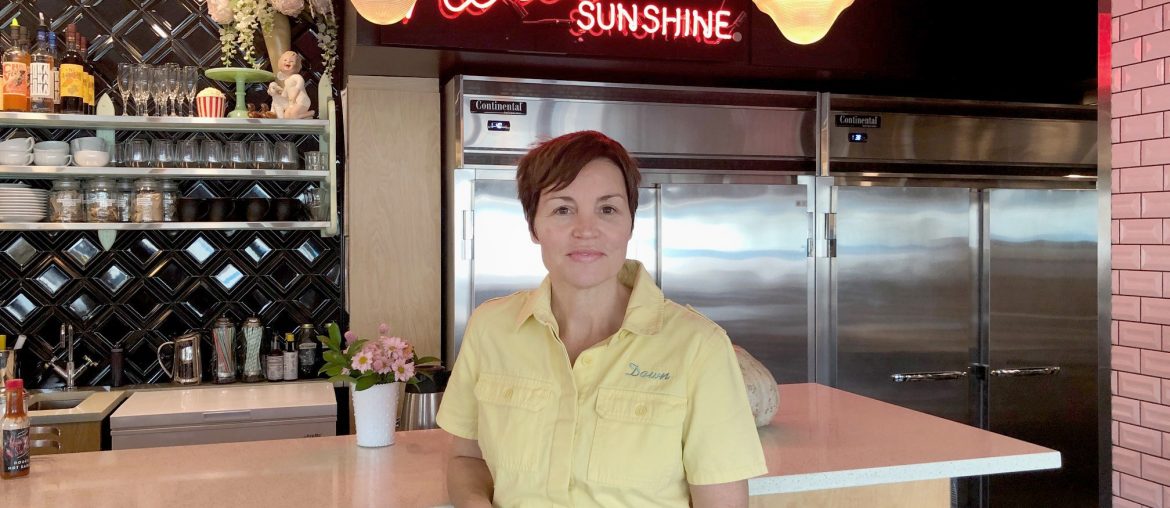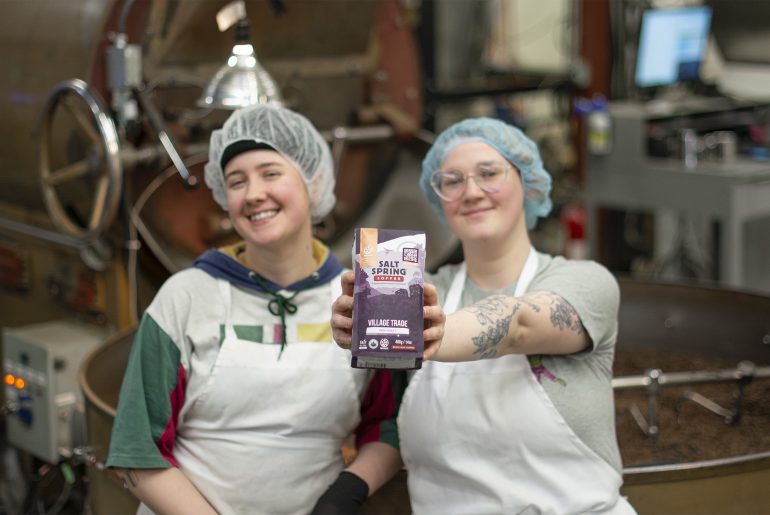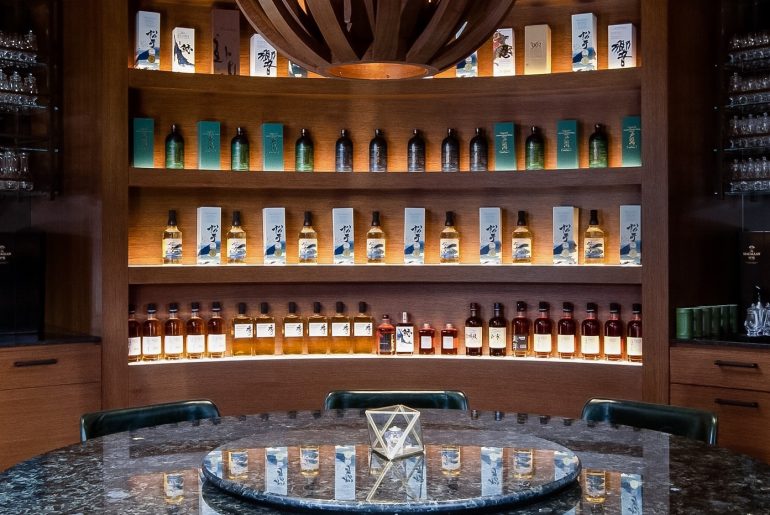By Gail Johnson
Chef Dawn Doucette has finally come home—home being the recently opened retro Douce Diner she runs with her husband, Nino Giangrande, at 1490 Pemberton Avenue in North Vancouver.
With its chrome napkin holders, swivel bar stools, ’50s colours (think lotus yellow, vintage pink, and mint green), and Motown soundtrack, Douce Diner is a slick throwback to another era, albeit with a refreshed, modern-day menu.
Doucette, a former Top Chef Canada competitor, is inspired by the likes of Berkeley, California chef Alice Waters, a pioneer of the slow-food, farm-to-plate movement. For her classic diner dishes, Doucette uses premium ingredients and a purist’s touch. The meat in the Double Douce Burger, for instance, is organic; the omelet is made with cage-free eggs; old-fashioned floats have vanilla gelato; and the banana split comes with freshly made strawberry compote.
Hand-spun milkshakes can be spiked with liqueurs, the diner using North Van distillers Sons of Vancouver’s vodka and amaretto for those and other cocktails. It partners with local roasters Casa del Caffé for espresso-based drinks.
Here, Doucette shares her culinary journey from small-town Saskatchewan to her dream corner diner.
Take us back, waaay back: what are some of your early memories of food and cooking?
I’m from Vancouver but grew up in Saskatchewan. When I was eight years old, my mom moved us back to Saskatoon. Sunday night suppers or late Sunday lunches at my grandmother’s in rural Saskatchewan—Delisle to be exact—were a real thing. She had a farm and grew her own vegetables. We had one cow and a chicken coop, so everything was fresh. She made bread a few times a week. She could make gravy out of anything, anything that was in the pan—it was so good! We never had desserts and cakes back then. We’d have a slice of bread to mop up the gravy.
It always meat and potatoes and vegetables, very Prairie-esque. But the corn came out the garden, and the strawberries were just picked. I remember the smells coming from the kitchen. My mom cooked really well too and did a lot of baking. She was a single mom, and there were four of us. We ate a lot of leftovers.
My sister [Timi Fuller] and I were out of the house at 17 and 18. We were always hosting dinner parties, throwing cocktail parties and making these fun drinks and canapés.
You moved back to Vancouver after high school and, after hosting and bussing at Earls Restaurant in Saskatoon, started working in the kitchen at Earls on Fir Street. Then it was off to the California Culinary Academy. What stands out for you from your training?
I did an internship at Zuni Café in San Francisco. Julie Rodgers [who has since passed] had worked with Alice Waters. That’s the stuff I wanted to do and was reminiscent of what I grew up with.
It was probably the toughest kitchen job I had. We changed the menu every day, twice a day. She didn’t allow a KitchenAid or Cuisinart; everything was chopped by hand. Her Caesar salad station… We used to call it the ‘seizure’ salad station. I would do 100 a night, all by hand. We had to toss with our hands; she didn’t use tongs or anything. You were tasting your vinegar, fresh egg yolk, minced anchovies that were cured in-house.
During pre-shift, she would talk about each dish. I’ll never forget one night, it was an avocado and fruit salad with endive; I remember plating it really pretty. She grabs my plate and says ‘this is how we do it. We don’t have time to frill it up. We like rustic. Stay true to your ingredient.’ That has always been embedded in my head. I like that style. I’ve adapted that philosophy and stay true to the ingredient. Less is more. And always work within season. That’s what I’ve tried to achieve here.
After working in various places in California and Ontario, where your husband is from, you came back to Vancouver and worked as a culinary development chef for Earls and Saltlick [the latter being part of the Fuller Group of Companies]. What did that role entail?
I didn’t even know those jobs existed. When I heard it was 9 to 5 and you get weekends off I just said, ‘you’re kidding.’ At Saltlick, my first mandate was to go through the whole menu and dissect it, look at sales what’s selling and what’s not selling, what food costs are high and what food costs are low, what was low labour and high labour, to really understand what works. From there I’d work my way backward to remove items or fix them if they weren’t working. It was such a big ship to steer.
At Earls, I was a creative, developing recipes. I helped develop the brigade of chefs that came in. You need a test team, someone to bounce ideas off one another. It was a really interesting, colourful experience for me.
After that, I decided to go into consulting, doing training at different restaurants and cafés. I’d take a look at what they were offering and how to make more profitable, writing recipes, training staff, organizing the kitchen, getting right tools and equipment for success. I did that for three or four years while raising my kids. It was very flexible and I worked a lot from home.
You were on Top Chef Canada in 2007. What was that experience like?
Top Chef was nerve-wracking. I had never competed before. It was a lot of drama. But I met my good friend Shelley Robinson [executive chef of UBC Okanagan] out of that, and she helped me with the Douce menu. There’s a group of ladies from that, incredible gals I still work with today and call good friends.
It also taught me how to behave in front of a camera. I’m not a nervous Nellie now. I’m quite comfortable in front of a camera now. If I were to do it again, I wouldn’t overthink things. You second guess yourself. Overall, I learned form that. It was very valuable.
How did Douce Diner come about?
My husband had been eying this particular location for eight years. He would come in with the kids and sit with the former owners and from day one would tell them ‘whenever you’re ready to sell, let me know.’ He would visit two to three times a month. After eight years, they were ready to sell.
We thought we’d give it a lipstick reno but lo and behold we ended up tearing out every wall right down to the studs. My sister came in to help with the design, and her eye to detail is incredible. She did so much research from the wallpaper to the chairs. She nailed it. We went back and forth and created a Pinterest board of both of our likes. I took it and put it into a storyboard format: this is how we want it to look, from the plateware to the packaging. I’m a visual person; I’ve got to see it.
What can you tell us about the menu?
I tried doing fancy and molecular cooking in the past, but that’s not me. Designing on half a plate is not me. I thought, ‘go back to your roots and remember grandma’s Sunday night suppers.’ It was about the smells. I love walking in here at 7 in the morning and smelling the hash browns and the bacon.
Everybody has an eggs benny on the menu, but I thought ‘how can I be different?’ Buttermilk biscuits were something my mom would make, and a friend from Alabama showed me how to do the layers. So right then and there that became my signature: eggs Benny on house-made buttermilk biscuits. I think it’s special.
The romesco [sauce] and French white beans on my 2 Eggs Any Style; I use a recipe my grandmother made. She used to cook white beans with ham hock and finish them with vinegar and salt. I want it clean and pure: clean cooking.
Avocado toast…. Everybody has an avocado toast on the menu, but there’s a reason why, and so I wanted to do it my way. It’s a pure, vegan dish with vegan smoked “vouda” cheese, organic vegan mayo, little gem tomatoes, pea sprouts and pea tendrils.
For my omelet, I didn’t want everything but the kitchen sink in there. I wanted it to be fluffy and aerated, nice and simple. That’s my whole philosophy.
There’s no dessert. I don’t bake. But I knew I had to do banana splits and milkshakes.
I’m happy here. And I want people to have a great experience.





Comments are closed.